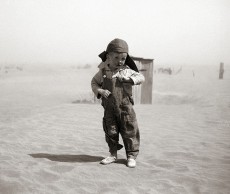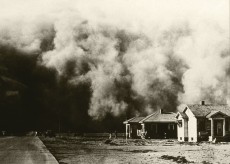By Hieu Truong/ reporter
People who moved west for better lives lost everything during the Dust Bowl, SE students learned Oct. 23.
SE history assistant professor Bradley Borougerdi led the discussion playing clips from Ken Burns’ documentary The Dust Bowl.

Library of Congress
“The Dust Bowl was one of the biggest catastrophic disasters in American history,” he said.
During the 1870s before the Dust Bowl, the government passed the Homestead Act. People could own land at little or no cost. Americans started migrating to the West for opportunities to make money and buying acres of land to farm and raise cattle.
“I saw the country transformed in the sunset glow,” The Dust Bowl narrator said. “All the brown prairie turned into gold.”
During this time, there was a surplus of grains in the Great Plains. Farmers had so many fields of grains that the United States was called the Breadbasket of the World. The supply and demand for grains increased transportation and agricultural technologies, Borougerdi said.
The economy was doing really well until the stock market crash in 1929, he said. Then the Dust Bowl took place in the 1930s when the Great Depression started.

Department of Agriculture
“It was as if the land had rejected them,” the film’s narrator said. “The rains stopped, and the winds came.”
During this period, the dust would cover farms and homes throughout the Great Plains. The dust was a mile high over their heads leaving the Great Plains in darkness for days, the narrator said. The crops were destroyed, and cattle were dying because of the drought and dust. Sand was everywhere. People were breathing and eating dirt, which led to pneumonia, he said.
“There is nowhere you can run,” said Dorothy Williamson, a Dust Bowl survivor from the film. “You can try to get out of it, but the dust follows you. There is no escaping.”
The Dust Bowl continued for years, and farmers were struggling to make a living. Some committed suicide, and others left their homes because the drought took over their lands, Borougerdi said. However, a group of farmers stayed back in hope that the next year would be better.
Farmers who stayed wanted to make up for what they lost, so they harvested more wheat. During the Dust Bowl, the wheat prices were dropping. The supply and demand for wheat was decreasing, and the government told the farmers to cut back on their productions, Borougerdi said.
Another disaster happened when hungry jackrabbits came and ate everything in their path. Farmers took extreme measures to get rid of the rabbits. So every Sunday, people got together to take sport in killing the rabbits, he said.
The Dust Bowl was an ecological disaster that tells a story about families who made sacrifices to survive, Borougerdi said.

